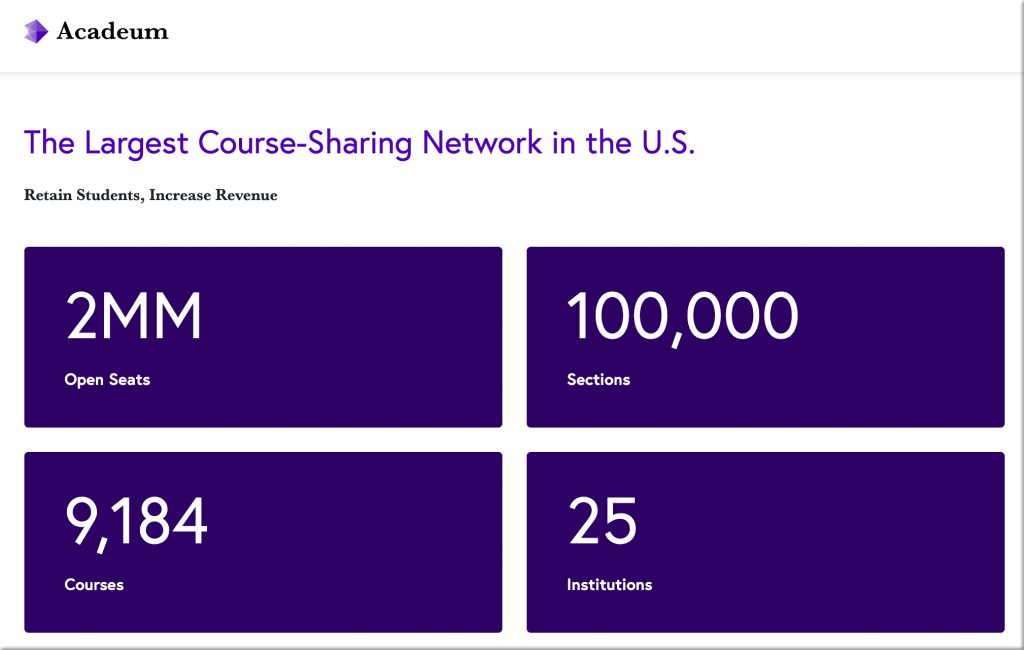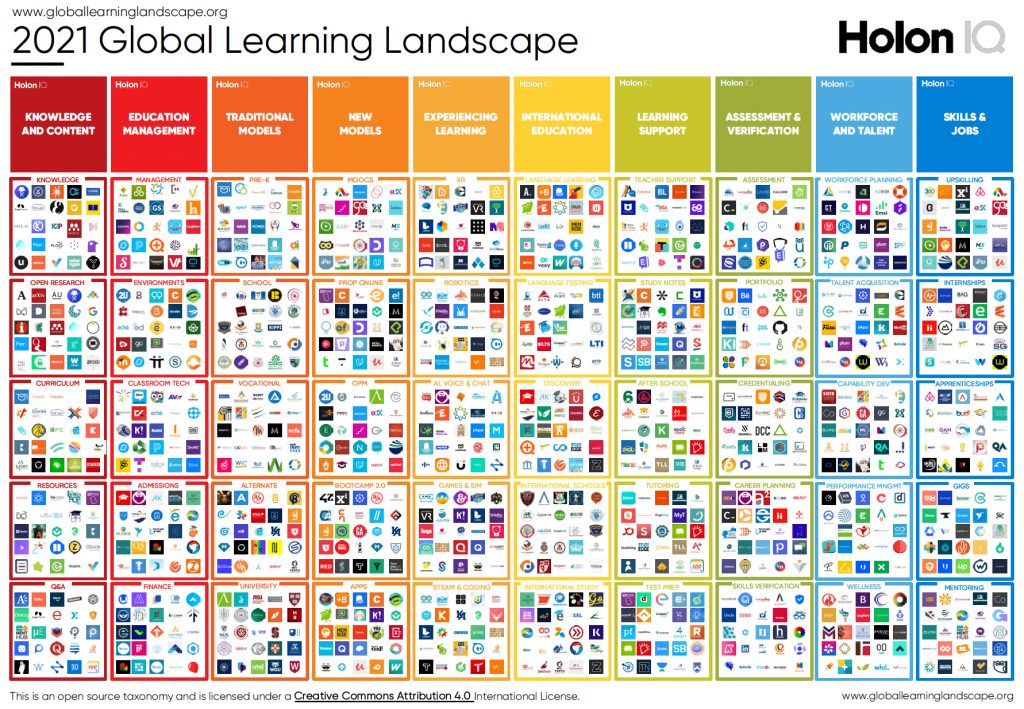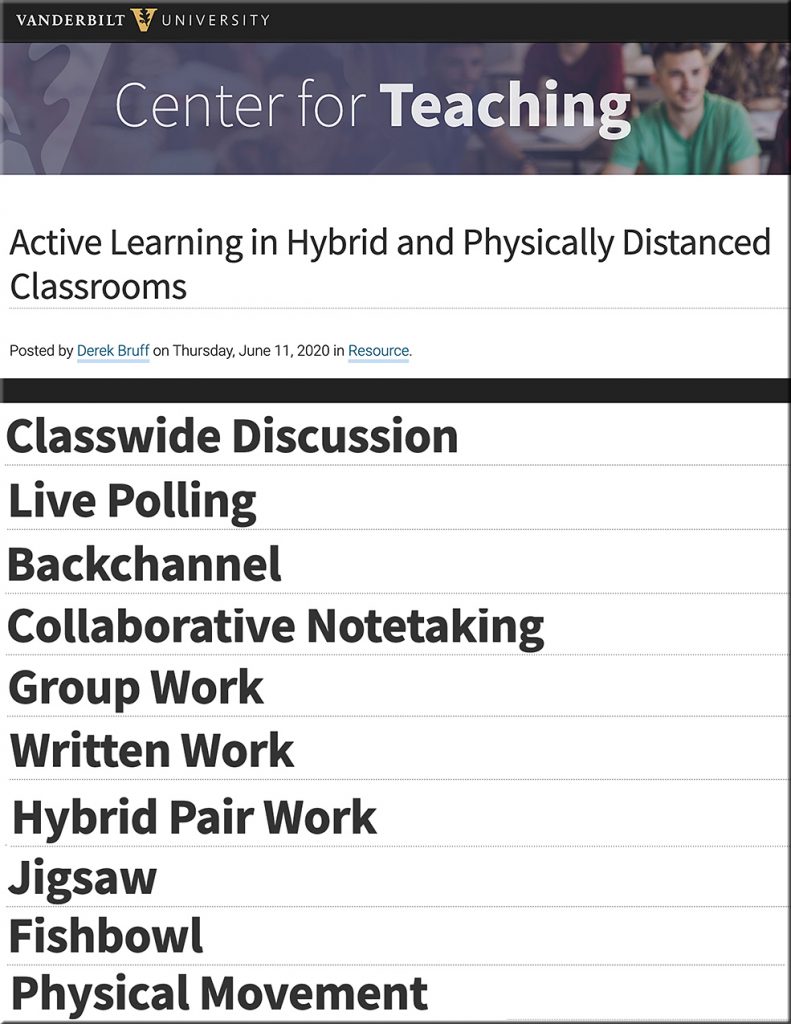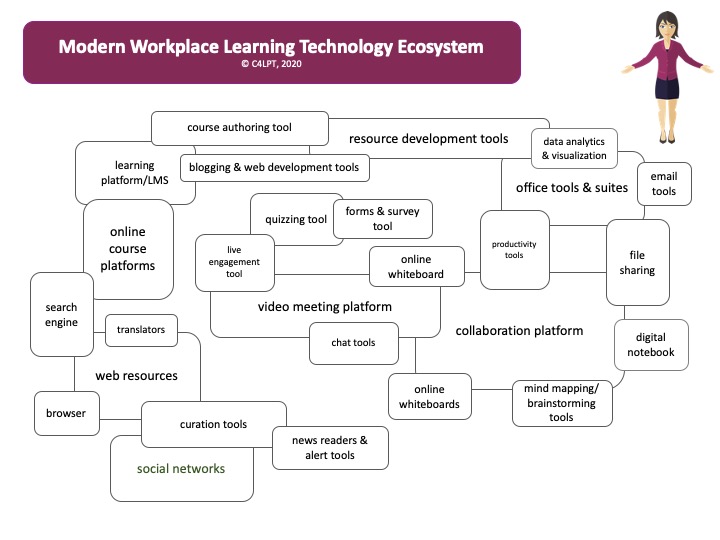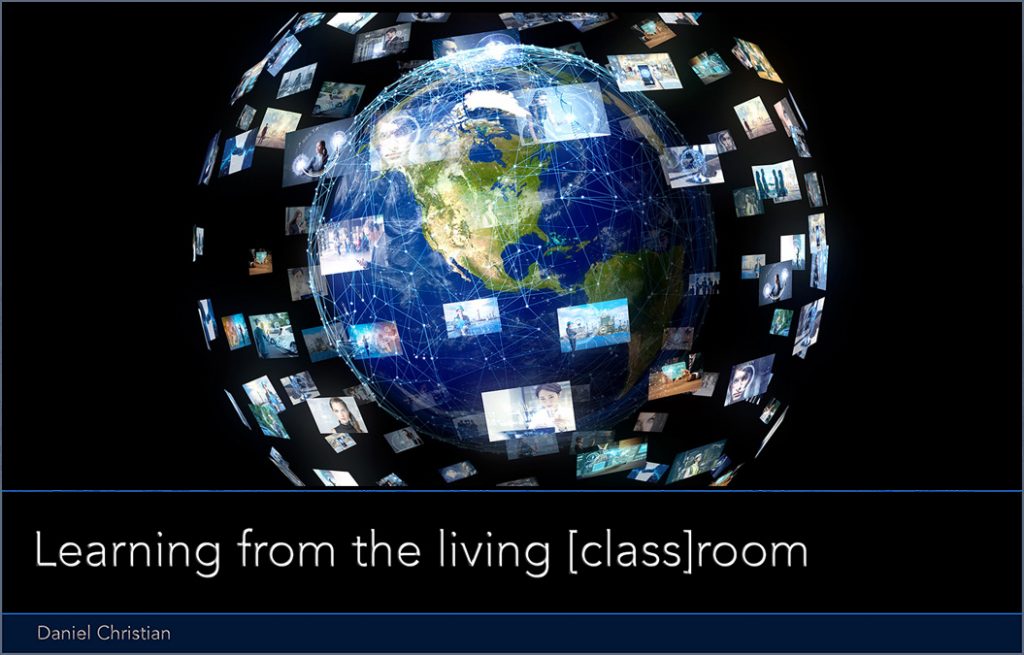Got science questions? Skype A Scientist can help — from bigthink.com by Scotty Hendricks
A non-profit dedicated to science communication offers to connect learners with over 11,000 scientists.
The pandemic pushed universities online. The change was long overdue. — from hbr-org.cdn.ampproject.org by Sean Gallagher and Jason Palmer; with thanks to Mike Mathews for his posting on LinkedIn re: this item
Excerpt:
A number of elite institutions — such as Princeton University, Williams College, Spelman College, and American University — have substantially discounted tuition for their fully online experience in an historically unprecedented fashion, highlighting pricing pressures and opening up Pandora’s box. This comes after a decade of growth in postsecondary alternatives, including “massively open online courses” (MOOCs), industry-driven certification programs, and coding bootcamps.
This moment is likely to be remembered as a critical turning point between the “time before,” when analog on-campus degree-focused learning was the default, to the “time after,” when digital, online, career-focused learning became the fulcrum of competition between institutions.
Radar trends to watch: October 2020 — from oreilly.com
Excerpt:
This month, the big surprise is that there’s no significant technology news about COVID. And there is more news than ever about legislation and regulation. I suspect that the legal system will be a big driver for technology over the next year. Another trend that doesn’t quite count as technology news but that definitely bears watching is that college enrollment in the US is down. Grad schools are up, 4 year colleges are down slightly; the big hit is in 2 year colleges. COVID is probably the biggest contributing factor, but regardless of the cause, this is an inauspicious trend.
The shift online has colleges looking to share courses — from educationdive.com by Alia Wong
Dozens of institutions have joined consortia for exchanging online classes since the pandemic began, and new options have sprung up.
Excerpts:
Dozens of other small, private institutions followed thanks to the Council of Independent Colleges’ (CIC’s) Online Course Sharing Consortium, which was formed in late 2018 and today is the largest of the dozen or so networks on Acadeum.
“You see this most fundamentally in Bitcoin and in blockchain. The keys will be more and more in the hands of the individual.”
DC: I could see cloud-based learner profiles along these lines too. Each individual will say who gets access to their profile. https://t.co/2jnWBTxeRs
— Daniel Christian (@dchristian5) September 29, 2020
From DSC:
Along these lines…
Sometimes, I think we need to be very careful with Artificial Intelligence (#AI) — which elements of it and which applications of it that we use in our society and which we don’t move forward with. But in the case of cloud-based learning profiles (some might say competency profiles), AI makes sense. Algorithms could make sense. Data mining could make sense.
A cloud-based learning profile might not make sense always to us — as it could be very large indeed. But AI-based algorithms could assist with finding appropriate matches between jobs, competencies, passions, skills, and candidates.
Such services will likely be part of a next-gen learning platform.
From DSC: What if each learner/person/student could have a lifelong, cloud-based “tribute” site?
What if you could hire a career coach to sift through the tributes to find common themes?
From DSC:
I recently asked friends and family to help me celebrate a significant birthday for my wife by creating a tribute for her — using a service called Tribute.co. It was a fun, meaningful, relational experience — it opened the doors to some great communications.
Here’s a video that describes what a Tribute is (from the company of that same name).
So I put out potential suggestions for what I hoped that we could relay to my wife, and people contributed their videos. Then a person at Tribute edited the videos to come up with a highlight reel. They also presented to my wife all of the videos, not just the highlight reel.
That got me to wonder, “What if each learner had a cloud-based, lifelong tribute site that parents, guardians, grandparents, teachers, coaches, musical directors, pastors, friends, and others could leave encouraging and instructive messages on? Or when they note something that might be of use later on in terms of career selection, they could “jot it down.” For example:
- [First-grade teacher] “I noticed Anne that when we did the art projects, you were enthralled with any sort of creative endeavor or project. We almost lost you in another world!”
- [Family member] “Tony, I’ve noticed ____. Here’s something to consider for your future pathways. Would you be interested in exploring _____ — such as if we signed you up for some lessons in that area?”
- [Eight grade teacher] “Eloise, I saw that your engagement level skyrocket when we studied ____, especially when you did the project on ___.”
- [Basketball coach] “Chan, I appreciated your hard work in practice today. Keep up the good work and you will be a super player! You are fast, strong, and seem to have a competitive spirit about you. Consider making a workout chart and charting out the workouts that you do each day. Monitor your progress over time. As of today, here are some apps to do just that: ___.
- [Pastor] “So glad Amanda that you were able to join us on our youth group visit to ___. I appreciated your end-of-the-day reflections on the experiences of the day. I also appreciated your hard work helping others.”
- [Friend] “It was great horsing around on Garageband with you today Zach. I look forward to diving into iMovie next with you. Let’s create a movie for each other. You seem to have a very creative side to you.”
- [High school CS Teacher] “Keep up the good work programming Jeremy! I hope that you will consider going into some type of job that uses critical thinking, mathematics, problem-solving — perhaps it will be programming, perhaps it will be engineering, or something else.”
- [College professor/advisor] “You mentioned that you hate college to me the last two times we met. You don’t seem happy studying ___. Have you considered ____?”
- [Tennis coach] Remember to bend those knees…get low. Keep your eyes on the seams of the ball.”
The idea behind such a service would be to offer encouragement, feedback, (if carefully put) constructive criticism, a message that “I’m on your team”…and/or…”Here’s what I see in you.”
Additional functionality/options
- Contributors:
- Like Twitter imposes a limit on characters, there could be options to impose a time limit on the length of a video, ability to add more than one video, and/or set a limit on how many videos someone can upload
- If submitting a written piece, the option would be there to limit the number of characters and/or the word count.
- From learners themselves (to their own tribute)
- No time limit, no word count or character limit
- Would act like a multimedia-based diary/journal of learning
- Option to select whether might be worth re-listening to for career selection purposes.
Learning in the Cloud: Canada’s First University to Move Operations into One Secure Cloud Infrastructure Sets the Stage for the Future of Learning — from globenewswire.com by Athabasca University
Athabasca University (AU) lays the groundwork to build a more accessible and personalized future for post-secondary learners
Excerpt:
Edmonton, Alberta, Sept. 23, 2020 (GLOBE NEWSWIRE) — At a time when you can personalize everything from your online shopping experience to your dating prospects, it seems only reasonable to ask: why can’t students “swipe right” on their course load? Why can’t a degree be structured around what someone wants to learn or how they learn, instead of what’s traditionally part of the program? In other words, why isn’t it possible to choose your own adventure in a university environment?
Athabasca University (AU), Canada’s Online University, recently completed a six-month rapid cloud migration project with Amazon Web Services (AWS) to construct a secure, flexible, and global infrastructure required to make personalized learning an infinitely scalable reality. With the completion of its cloud migration project, AU became the first post-secondary institution in Canada to move its entire digital operations infrastructure into its own secure AU cloud environment powered by AWS.
Quick survey: What is the one tech (product, platform, etc.) that has been essential to you in working from home?
— Bob Ambrogi (@bobambrogi) September 23, 2020
Zoom, but for X: How startups are building for our new video normal — from protocol.com by Biz Carson
Meet the startups building the next take on video.
Excerpt (emphasis DSC):
Trying to liven up the monotony of Zoom meetings, Phil Libin hung up a green towel behind his desk and started projecting images onto it, like Dr. Anthony Fauci hovering over his shoulder, just to make his team laugh. At first, it was a bit of a performance and a way to break up the monotony as Zoom fatigue set in a few months into the pandemic at the end of May. But then Libin, the former CEO of Evernote and founder of startup studio All Turtles, realized the “Weekend Update” style could be more than just a gimmick.
A bit of coding and a fantastic demo later, Libin closed a seed round of $4.5 million to launch his new company, Mmhmm. His big belief is that we’re moving to a hybrid world where things don’t fit neatly into boxes like in-person or online or live or recorded. Instead, it’s all going to be a mix.
Also see:
Teaching in a Hybrid Classroom – What’s Working, What’s Not — from derekbruff.org by Derek Bruff
Excerpt:
Now that we’re a few weeks into the semester, I wanted to know what was working and what was a continuing challenge for instructors, so I convened a conversation on teaching earlier this week attended by 18 of my faculty colleagues representing a range of disciplines. They were excited to be back in the classroom this fall. “There’s a different energy when we’re face-to-face,” one of them said. We had a lively discussion via Zoom about hybrid teaching, including what made it exciting and what made it frustrating, and I wanted to share a few highlights here on the blog.
I waited a minute or two while the participants thought and typed, and when it was clear that most of the participants were no longer typing, I said, “Ready, set, go!” Everyone hit enter, and a slew of responses appeared in the chat at the same time. At this point, we all spent a couple of minutes reading through the responses. I selected a couple that were particularly interesting and called on those participants to elaborate via video.
Also see:
Active Learning in Hybrid and Physically Distanced Classrooms — from cft.vanderbilt.edu by Derek Bruff
If I’m standing at the front of the classroom with half or a third of my students in the room with me, but sitting six feet apart from each other and wearing masks, while the rest of my students are joining class by videoconference, what strategies might I employ to engage all of my students in meaningful learning?
I’m going to try to outline some options here in this blog post, drawing on ideas and resources from across the higher education community, but I would enthusiastically welcome additional approaches in the comments below or via Hypothesis annotations.
Derek Bruff
Thanks to Jane Hart for the below diagram of a learning technology ecosystem! This diagram is accessible out at Jane’s recent posting entitled, “Back to Basics: 10 lessons for virtual L&D for 2021.“
From DSC:
Notice how these tools, vendors, business relationships, etc. can — and do — morph over time. It’s not a static system…but an ever-changing system.
Per this week’s Lecture Breakers Weekly! from Dr. Barbi Honeycutt:
Break up your online lectures with the Watch Party! Here’s how you can do it:
- Pre-record your mini-lecture or find a video you want to use for your lesson.
- Instead of asking students to watch the video on their own, play it during your synchronous/live class time.
- Explain to your students that they are watching the video all at the same time and that you will be facilitating the chat and answering their questions as they watch the video together. It’s a watch party!
- Option: Take the conversation out of Zoom or your LMS. Create a hashtag for your course on Twitter and invite other experts, colleagues, or friends to join the conversation.
Instead of presenting during the synchronous class time, you can now focus completely on managing the chat, prompting discussion, and responding to students’ questions and ideas in real-time. And be sure to record and save the chat for students who couldn’t attend the live session or want to review it later.
From DSC:
This is one of the kind of things that I envisioned with Learning from the living class[room] — a next-generation, global learning platform.
Learners could be watching a presentation/presenter, but communicating in real-time with other learners. Perhaps it will be a tvOS-based app or something similar. But TV as we know it is changing, right? It continues to become more interactive and on-demand all the time. Add videoconferencing apps like Zoom, Cisco Webex Meetings, Blackboard Collaborate, Microsoft Teams, Adobe Connect and others, and you have real-time, continuous, lifelong, relevant/timely, affordable, accessible, up-to-date learning.
Also, you have TEAM-BASED learning.
DC: This isn’t helping the continued backlash against traditional institutions of higher education.”#highereducation #debt #tuition #learningfromthelivingclassroom #learningecosystems
— Daniel Christian (@dchristian5) September 4, 2020
From DSC:
The perfect storm continues to build against traditional institutions of higher education. The backlash continues to build strength. And there WILL BE change — there’s no choice now. Alternatives to these traditional institutions of higher education continue to appear on the scene.
Over the last several decades, traditional institutions of higher education had the chance to step in and do something. They didn’t take nearly enough action. As in other industries, these days of the Coronavirus just hasten the changes that were already afoot.
Also see:
- Alternative Credentials on the Rise — from insidehighered.com by Paul Fain, with thanks to Ryan Craig for this resource
Interest is growing in short-term, online credentials amid the pandemic. Will they become viable alternative pathways to well-paying jobs?












